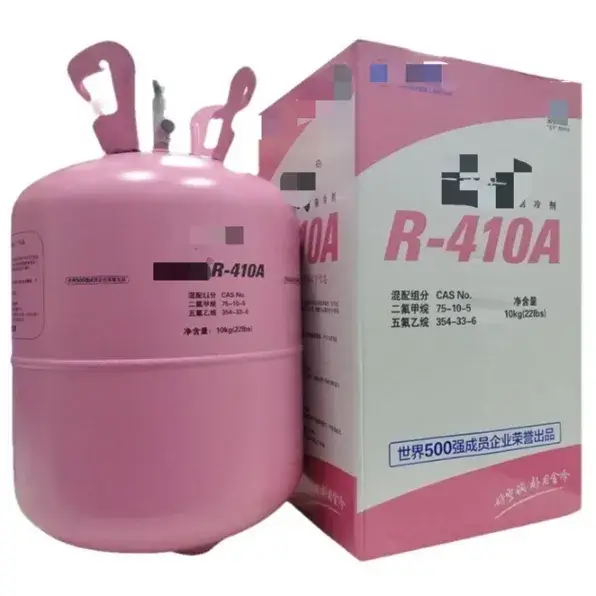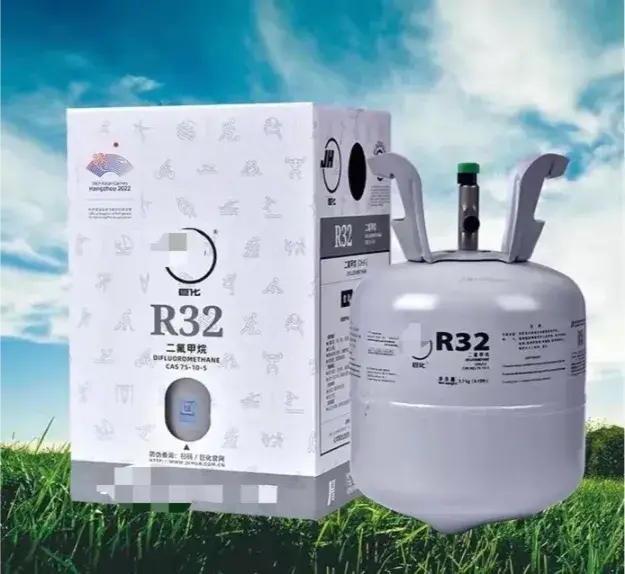Chiller Refrigerant Showdown: R410A VS R32
Chiller Refrigerant Showdown: R410A VS R32
What is refrigerant?
Refrigerant, also known as coolant or refrigerant, is the medium used in various thermal machines to facilitate energy conversion. It’s often synonymous with fluorocarbons. Cependant, due to their detrimental effects on the ozone layer, notably with compounds like chlorofluorocarbons (CFCs) and hydrochlorofluorocarbons (HCFCs), there’s been a shift towards more environmentally friendly options. Enter R32 and R410A, the new kids on the block in refrigerants. These two types have largely replaced ozone-depleting substances in chillers and other cooling systems.
What is a flammable refrigerant?
Flammable refrigerants are substances used in cooling systems that can ignite under certain conditions. They are crucial components in applications such as air conditioning, refrigeration, and heat pump systems.
The critical role of refrigerants in cooling systems:
The choice of refrigerant not only impacts the performance of these systems but also affects the environment. As climate change drives global temperatures upward, the demand for sustainable and eco-friendly refrigerants becomes more pressing than ever.
Refrigerants serve as the lifeblood of any cooling system, absorbing heat from indoor spaces and releasing it outdoors. Without efficient refrigerants, cooling equipment like chillers would become ineffective.
Characteristics of R410A refrigerant

- Does not deplete the ozone layer: With no chlorine elements in its molecular formula, it boasts an ozone depletion potential (ODP) of zero. Its global warming potential (GWP) is 2025.
- Extremely low toxicity: Its permissible concentration is the same as R22, both at 1000ppm.
- Non-flammable: Its flammability in air is zero.
- High chemical and thermal stability.
- Similar water solubility to R22.
- A blend refrigerant composed of two refrigerants.
- Does not dissolve in mineral oil or alkyl benzene oil. (Compatible with POE [ester lubricating oil] and PVE [ether lubricating oil].)
- Does not dissolve in mineral oil or alkyl benzene oil. (Compatible with POE [ester lubricating oil] and PVE [ether lubricating oil].)
Advantages of R410A:
- Safety and reliability: R410A refrigerant is safer compared to other refrigerants, with lower flammability and explosiveness, reducing safety risks during equipment operation.
- Environmentally friendly and energy-efficient: We prioritize environmental protection, hence the choice of R410A as an eco-friendly refrigerant. It has a lower global warming potential (GWP), minimizing its impact on the ozone layer and global climate change, in line with international environmental standards.
- High stability: R410A refrigerant performs excellently under various conditions, boasting outstanding thermodynamic properties to ensure high cooling (or heating) efficiency of your equipment, reducing energy consumption and saving operating costs.
Disadvantages of R410A:
- Environmental Impact: Although the GWP of R410A is already low, it is still slightly higher than that of R32.
- Higher costs: Being a blend refrigerant, R410A is produced by mixing R32 and R125 in a 1:1 ratio, which is more complex and thus more costly to manufacture.
Characteristics of R32 refrigerant

R32, also known as difluoromethane, is a refrigerant with zero ozone depletion potential.
Here are its main characteristics:
- Outstanding environmental friendliness: With no chlorine elements in its molecular formula, R32 doesn’t deplete the ozone layer. Its ozone depletion potential (ODP) is 0, and its global warming potential (GWP) is lower than that of R410A, at 675.
- Extremely low toxicity: R32 shares the same permissible concentration as R22, both at 1000ppm, making it extremely safe to use.
- High stability: R32 exhibits excellent chemical and thermal stability, ensuring consistent performance under various conditions.
- Good water solubility: Its water solubility is almost identical to R22, aiding in managing moisture effects within refrigeration systems.
- Lubricant compatibility: R32 is compatible with POE (ester lubricating oil) and PVE (ether lubricating oil) but not with mineral oil or alkyl benzene oil.
Advantages of R32:
- Environmental friendliness: As a refrigerant with low global warming potential (GWP), R32 has a slightly lower GWP than R410A, minimizing its impact on the ozone layer and global warming.
- High efficiency: R32 boasts excellent thermodynamic properties, resulting in higher cooling efficiency and improved energy efficiency ratio (EER) for chillers.
- Ease of charging: Compared to R410A, R32 requires less charge, providing greater flexibility in refrigeration system design and installation.
Disadvantages of R410A:
Flammability: R32 is a flammable refrigerant, which has tarnished its reputation due to past incidents of air conditioning explosions caused by R32 leakage. Contact with air can lead to explosions if exposed to an open flame, necessitating extra precautions for safety during operation and maintenance of chiller systems.
Summary:
R410A is a blend refrigerant, consisting of R32 and R125 mixed in a 1:1 ratio, which makes production more complex and costly. En revanche, R32 has lower costs and requires less usage compared to R410A. Cependant, does R32 have no drawbacks? Of course, it does. One major drawback of R32 is its flammability. If R32, a flammable gas, encounters air and an open flame, it can lead to explosions. En plus, R32 operates at higher pressures, making copper pipes more prone to leakage, especially if manufacturers cut corners by using thinner copper pipes, which can have catastrophic consequences.
Most brands use R32 refrigerant, with a few opting for R410A primarily due to its lower cost, lower investment, and higher cooling efficiency. Cependant, in the central air conditioning field (whether it’s Hitachi central air conditioning, Daikin, Mitsubishi, Toshiba, or high-end domestic models), our company exclusively uses R410A refrigerant for every water chiller. This choice emphasizes stability and safety.
As for which one to choose, it ultimately depends on individual preferences and priorities. While R32 is relatively cheaper than R410A and may be suitable for short-term use, considering the advanced technology and the long-term nature of chiller usage, prioritizing safety, R410A is recommended. After all, refroidisseurs d'eau are not disposable items but long-term investments, and it’s crucial to prioritize safety in the decision-making process.
L'affaire devant lui
Vous voulez aussi les connaître…
L'affaire devant lui
Chiller Refrigerant Showdown: R410A VS R32
What is refrigerant?
Refrigerant, also known as coolant or refrigerant, is the medium used in various thermal machines to facilitate energy conversion. It’s often synonymous with fluorocarbons. Cependant, due to their detrimental effects on the ozone layer, notably with compounds like chlorofluorocarbons (CFCs) and hydrochlorofluorocarbons (HCFCs), there’s been a shift towards more environmentally friendly options. Enter R32 and R410A, the new kids on the block in refrigerants. These two types have largely replaced ozone-depleting substances in chillers and other cooling systems.
What is a flammable refrigerant?
Flammable refrigerants are substances used in cooling systems that can ignite under certain conditions. They are crucial components in applications such as air conditioning, refrigeration, and heat pump systems.
The critical role of refrigerants in cooling systems:
The choice of refrigerant not only impacts the performance of these systems but also affects the environment. As climate change drives global temperatures upward, the demand for sustainable and eco-friendly refrigerants becomes more pressing than ever.
Refrigerants serve as the lifeblood of any cooling system, absorbing heat from indoor spaces and releasing it outdoors. Without efficient refrigerants, cooling equipment like chillers would become ineffective.
Characteristics of R410A refrigerant

- Does not deplete the ozone layer: With no chlorine elements in its molecular formula, it boasts an ozone depletion potential (ODP) of zero. Its global warming potential (GWP) is 2025.
- Extremely low toxicity: Its permissible concentration is the same as R22, both at 1000ppm.
- Non-flammable: Its flammability in air is zero.
- High chemical and thermal stability.
- Similar water solubility to R22.
- A blend refrigerant composed of two refrigerants.
- Does not dissolve in mineral oil or alkyl benzene oil. (Compatible with POE [ester lubricating oil] and PVE [ether lubricating oil].)
- Does not dissolve in mineral oil or alkyl benzene oil. (Compatible with POE [ester lubricating oil] and PVE [ether lubricating oil].)
Advantages of R410A:
- Safety and reliability: R410A refrigerant is safer compared to other refrigerants, with lower flammability and explosiveness, reducing safety risks during equipment operation.
- Environmentally friendly and energy-efficient: We prioritize environmental protection, hence the choice of R410A as an eco-friendly refrigerant. It has a lower global warming potential (GWP), minimizing its impact on the ozone layer and global climate change, in line with international environmental standards.
- High stability: R410A refrigerant performs excellently under various conditions, boasting outstanding thermodynamic properties to ensure high cooling (or heating) efficiency of your equipment, reducing energy consumption and saving operating costs.
Disadvantages of R410A:
- Environmental Impact: Although the GWP of R410A is already low, it is still slightly higher than that of R32.
- Higher costs: Being a blend refrigerant, R410A is produced by mixing R32 and R125 in a 1:1 ratio, which is more complex and thus more costly to manufacture.
Characteristics of R32 refrigerant

R32, also known as difluoromethane, is a refrigerant with zero ozone depletion potential.
Here are its main characteristics:
- Outstanding environmental friendliness: With no chlorine elements in its molecular formula, R32 doesn’t deplete the ozone layer. Its ozone depletion potential (ODP) is 0, and its global warming potential (GWP) is lower than that of R410A, at 675.
- Extremely low toxicity: R32 shares the same permissible concentration as R22, both at 1000ppm, making it extremely safe to use.
- High stability: R32 exhibits excellent chemical and thermal stability, ensuring consistent performance under various conditions.
- Good water solubility: Its water solubility is almost identical to R22, aiding in managing moisture effects within refrigeration systems.
- Lubricant compatibility: R32 is compatible with POE (ester lubricating oil) and PVE (ether lubricating oil) but not with mineral oil or alkyl benzene oil.
Advantages of R32:
- Environmental friendliness: As a refrigerant with low global warming potential (GWP), R32 has a slightly lower GWP than R410A, minimizing its impact on the ozone layer and global warming.
- High efficiency: R32 boasts excellent thermodynamic properties, resulting in higher cooling efficiency and improved energy efficiency ratio (EER) for chillers.
- Ease of charging: Compared to R410A, R32 requires less charge, providing greater flexibility in refrigeration system design and installation.
Disadvantages of R410A:
Flammability: R32 is a flammable refrigerant, which has tarnished its reputation due to past incidents of air conditioning explosions caused by R32 leakage. Contact with air can lead to explosions if exposed to an open flame, necessitating extra precautions for safety during operation and maintenance of chiller systems.
Summary:
R410A is a blend refrigerant, consisting of R32 and R125 mixed in a 1:1 ratio, which makes production more complex and costly. En revanche, R32 has lower costs and requires less usage compared to R410A. Cependant, does R32 have no drawbacks? Of course, it does. One major drawback of R32 is its flammability. If R32, a flammable gas, encounters air and an open flame, it can lead to explosions. En plus, R32 operates at higher pressures, making copper pipes more prone to leakage, especially if manufacturers cut corners by using thinner copper pipes, which can have catastrophic consequences.
Most brands use R32 refrigerant, with a few opting for R410A primarily due to its lower cost, lower investment, and higher cooling efficiency. Cependant, in the central air conditioning field (whether it’s Hitachi central air conditioning, Daikin, Mitsubishi, Toshiba, or high-end domestic models), our company exclusively uses R410A refrigerant for every water chiller. This choice emphasizes stability and safety.
As for which one to choose, it ultimately depends on individual preferences and priorities. While R32 is relatively cheaper than R410A and may be suitable for short-term use, considering the advanced technology and the long-term nature of chiller usage, prioritizing safety, R410A is recommended. After all, refroidisseurs d'eau are not disposable items but long-term investments, and it’s crucial to prioritize safety in the decision-making process.
L'affaire devant lui
Vous voulez aussi les connaître…
À propos de l'auteur

Bienvenue sur notre blog! Je m'appelle Peter et je suis l'auteur principal de ce blog. En tant que praticien de la récupération sportive et possédant de profonds intérêts et expertise.
Je m'engage à présenter des concepts complexes de manière claire et concise, et permettre aux lecteurs de mieux comprendre et appliquer ces connaissances grâce à des recherches approfondies et au partage d'expériences.
Merci d'avoir lu et pour votre soutien! Si vous avez des questions ou des suggestions sur l'un des contenus, N'hésitez pas à me contacter. J'ai hâte de partager des informations plus intéressantes et utiles avec vous et de grandir ensemble dans ce voyage de connaissances.!
